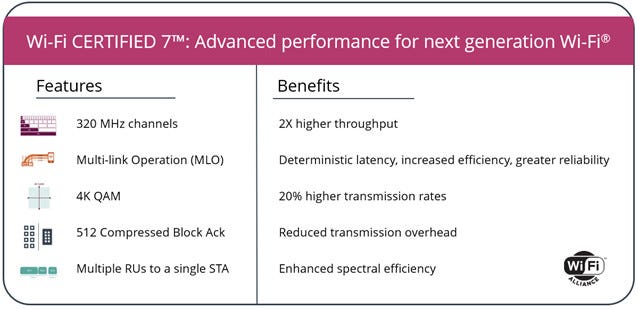January 9, 2024

Wi-FI 7 promises high throughput, deterministic latency, and greater reliability for critical traffic. To the laymen it’s an upgrade to Wi-Fi 6 and 6E that will mean faster connections for devices in the home and perhaps make the most out of that hefty full fibre connection.
The point of certification is that devices can be badged as being interoperable with others using the wireless standard, and The Wi-Fi Alliance says Wi-Fi 7 will usher in new tech use cases and enhance existing activities such as such as multi-user AR/VR/XR, immersive 3D training, gaming, hybrid work, industrial IoT, and automotive applications.
Smartphones, PCs, tablets, and access points (APs) will be the earliest adopters of Wi-Fi 7, says the alliance, and customer premises equipment (CPE) and augmented and virtual reality (AR/VR) equipment will ‘continue to gain early market traction’. Overall, 233 million devices will enter the market in 2024, increasing to 2.1 billion devices by 2028, we’re told.
"The introduction of Wi-Fi Certified 7 marks the emergence of the latest generation of Wi-Fi and will be an accelerant to mass adoption of Wi-Fi 7,” said Kevin Robinson, president and CEO, Wi-Fi Alliance. “This certification underscores our relentless commitment to delivering cutting-edge technology that redefines the way users experience Wi-Fi, providing faster speeds, improved efficiency, and increased reliability which expand the horizons of what is possible through Wi-Fi."
In terms of the nitty-gritty tech specs of the wireless standards, amongst its promised features are 320 MHz channels which ‘double today’s widest channel size to facilitate multigigabit device speeds and high throughput’, Multi-Link Operation which allows devices to transmit and receive data simultaneously over multiple links, and 4K QAM which boasts 20% higher transmission rates than 1024 QAM.

Broadcom, CommScope Ruckas Networks, Intel, MaxLinear, MediaTek, and Qualcomm formed the test bed for certification and are among the first off the blocks with Wi-Fi Certified 7 devices.
Rahul Patel, Senior Vice President and General Manager, Connectivity, Broadband and Networking, Qualcomm Technologies added: “Wi-Fi 7 is a game-changing evolution of Wi-Fi, elevating wireless connectivity to unprecedented heights of performance. The Qualcomm FastConnect 7800 and Networking Pro Series Platforms are powering millions of Wi-Fi 7 smartphones, PCs, and access points today, and we are honoured that both are included in the certification test bed.
“We are thrilled our customers are experiencing our full-featured Wi-Fi 7 implementations across our product portfolio, including 320 MHz channels, Multi-Link Operation maximized for robust performance at range, and improvements to enhance manageability of platforms. Together, we are racing forward, ushering in a broad ecosystem of Wi-Fi 7 networks, devices and use cases that will help redefine the world in which we live, work, and connect.”
Eric A McLaughlin, VP & GM Wireless Solutions Group at Intel Corporation added: “Congratulations to Wi-Fi Alliance for the launch of the Wi-Fi CERTIFIED 7. Intel-powered PCs and IOT products with Wi-Fi 7 will enable multi-gigabit speeds with wired-like responsiveness and new extreme levels of connection reliability. Ecosystem collaboration and interoperability are essential to help deliver on these expectations. We are delighted that our new Intel Wi-Fi 7 BE200 solution has been officially certified and included in the program test bed to help make great user experiences possible with other Wi-Fi 7 devices.”
The most immediate benefit of getting Wi-Fi 7 devices hooked up around the home will be to make the most of a fibre connection. But as explained in the various proclamations above, the ambitions of its architects are loftier than spreading around that bandwidth a bit better and rounding out any dead spots.
In September last year Qualcomm held a Wi-Fi 7 day, in which various speakers sketched out their visions of the future of home and business internet use – which was broadly along a consensus that there will be much more bandwidth demands in the years to come as things like VR, AR, XR devices get off the ground.
Rather than an incremental performance improvement – which is nothing to be sniffed at if you’ve ever had to struggle with getting wifi working optimally in a tricky domestic set up – it is these new types of gadget than Wi-Fi 7’s potential is being pitched as supporting.
The issue remains at the present moment there isn’t overwhelming demand for the current raft of mixed reality devices – Apple made a splash with the Vision Pro, but its price point is going to rule out all a lot of people. But with CES in full swing this week, perhaps something will stand out from the deluge of tech launches that piques the interest of the average consumer, and their wallet.
You May Also Like









_1.jpg?width=700&auto=webp&quality=80&disable=upscale)


.png?width=800&auto=webp&quality=80&disable=upscale)